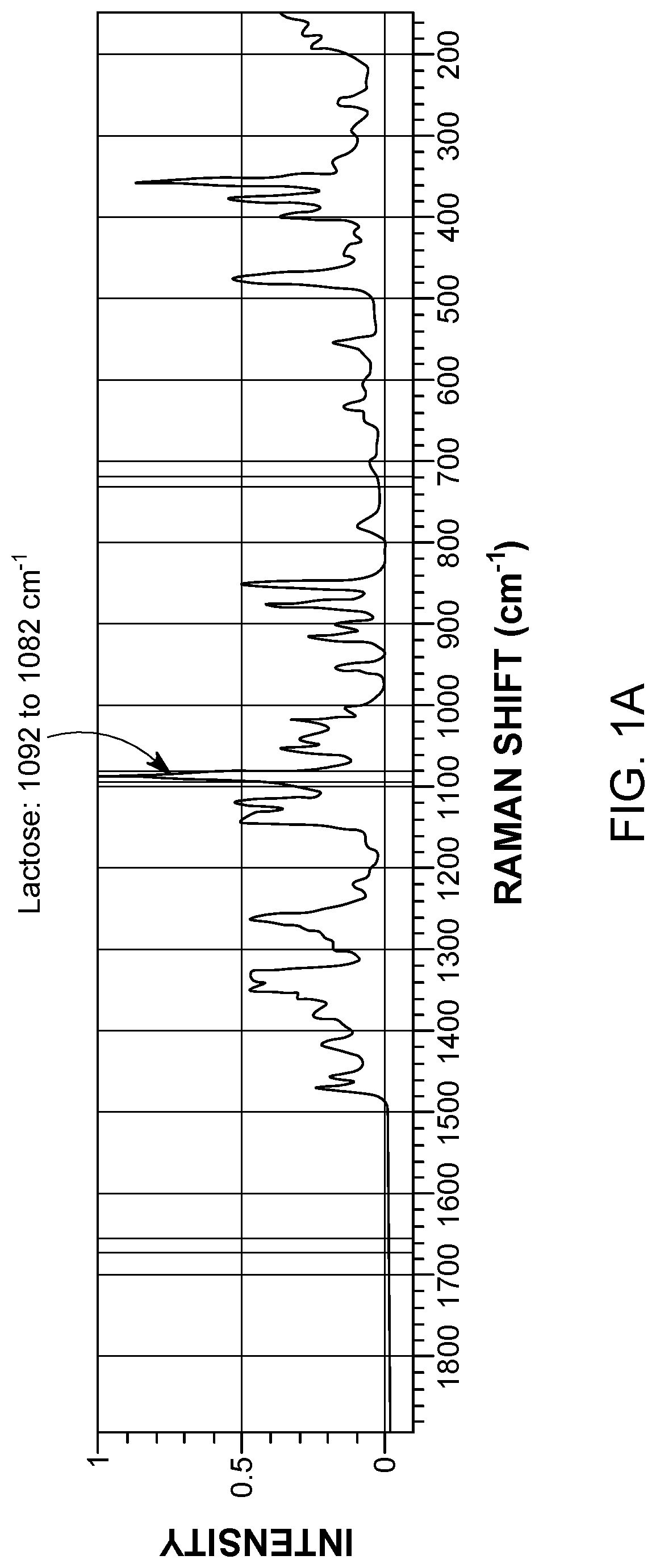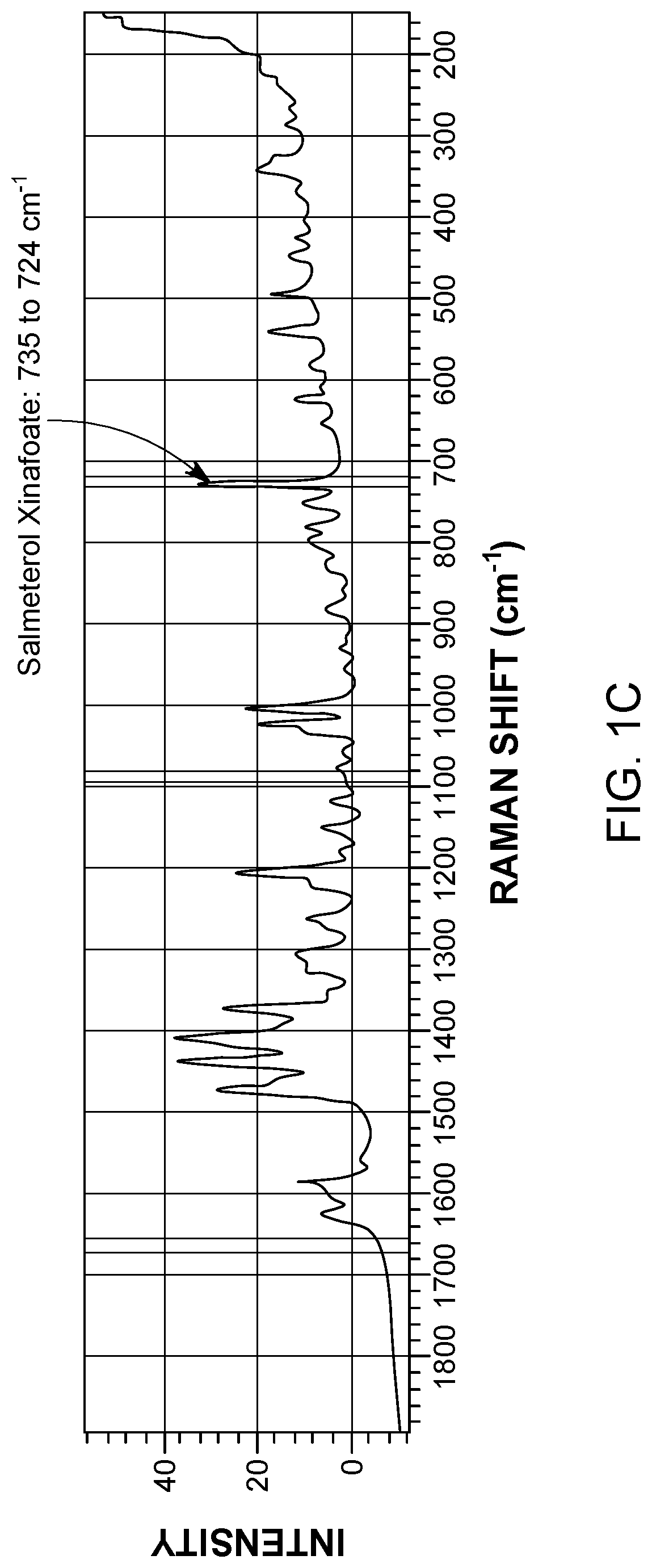Application of raman spectroscopy for the manufacture of inhalation powders
a technology of raman spectroscopy and powder manufacturing, applied in the direction of spectrometry/spectrophotometry/monochromators, optical radiation measurement, instruments, etc., can solve the problems of difficult drug dispersion, difficult process of manufacturing powder blends containing micronized apis, and complicated powder manufacturing process
- Summary
- Abstract
- Description
- Claims
- Application Information
AI Technical Summary
Benefits of technology
Problems solved by technology
Method used
Image
Examples
examples
[0099]The following non-limiting examples are provided to further illustrate the present invention.
Materials
[0100]Micronized fluticasone propionate (D90=2.5 microns to 6 microns), micronized salmeterol xinafoate (D90=2.5 microns to 6 microns), micronized albuterol sulfate (D90=2.5 microns to 6 microns), and alpha-lactose monohydrate (D90=100 microns to 300 microns) were used. The formulations used in these experiments are representative of dry powder inhaler formulations used in commercial pharmaceutical manufacturing.
[0101]A Raman spectrum for each component was collected prior to the blending experiments. The Raman spectra for the components were compared to one another to identify Raman peaks exclusive to each component. As shown in FIG. 1, the Raman spectrum of α-lactose monohydrate did not interfere with the characteristic Raman peaks of fluticasone propionate (1672-1654 cm−1) or salmeterol xinafoate (735-724 cm−1). As shown in FIG. 2, the Raman spectrum of α-lactose monohydrat...
experiment 1
n Spectroscopy Used to Monitor Blending of Fluticasone Propionate, Salmeterol Xinafoate, and Lactose Monohydrate
[0104]In a first experiment, the active ingredients fluticasone propionate and salmeterol xinafoate were used to manufacture two dry powder blends. α-Lactose monohydrate was the only excipient (carrier agent) in the blend. The impact of blender speed was assessed in Part A and Part B of the experiment, as shown in Table 1 below.
TABLE 1Variables for Experiment 1BlenderCollectionExperi-Wt.Speed Time mentComponent%(rpm)(min)1Afluticasone propionate0.8245030(low salmeterol xinafoate0.58speed)α-lactose monohydrate98.61Bfluticasone propionate0.82125030(high salmeterol xinafoate0.58speed)α-lactose monohydrate98.6
[0105]A 2 L stainless steel blender bowl having a sapphire window incorporated on the side to enable remote monitoring was charged with fluticasone propionate, salmeterol xinafoate and α-lactose monohydrate (see amounts in Table 1). The components were blended using a hig...
experiment 2
n Spectroscopy Used to Monitor Blending of Fluticasone Propionate, Albuterol Sulfate, and Lactose Monohydrate
[0111]In a second experiment, the active ingredients fluticasone propionate and albuterol sulfate were used to manufacture three dry powder blends. α-Lactose monohydrate was the only excipient (carrier agent) in the blends. The effect of API concentration was assessed in Parts A-C of the experiment. Three different blends containing three different concentrations of fluticasone propionate and albuterol sulfate were blended at high speed, as shown in Table 2 below.
TABLE 2Variables for Experiment 2BlenderCollectionExperi-Wt. Speed Time mentComponent%(rpm)(min)2Afluticasone propionate0.25125060albuterol sulfate1.13α-lactose monohydrate98.622Bfluticasone propionate0.375125060albuterol sulfate1.695α-lactose monohydrate97.932Cfluticasone propionate0.50125060albuterol sulfate2.26lactose monohydrate97.24
[0112]A 2 L stainless steel blender bowl having a sapphire window incorporated on...
PUM
| Property | Measurement | Unit |
|---|---|---|
| Time | aaaaa | aaaaa |
| Time | aaaaa | aaaaa |
| Time | aaaaa | aaaaa |
Abstract
Description
Claims
Application Information
 Login to View More
Login to View More - R&D
- Intellectual Property
- Life Sciences
- Materials
- Tech Scout
- Unparalleled Data Quality
- Higher Quality Content
- 60% Fewer Hallucinations
Browse by: Latest US Patents, China's latest patents, Technical Efficacy Thesaurus, Application Domain, Technology Topic, Popular Technical Reports.
© 2025 PatSnap. All rights reserved.Legal|Privacy policy|Modern Slavery Act Transparency Statement|Sitemap|About US| Contact US: help@patsnap.com



